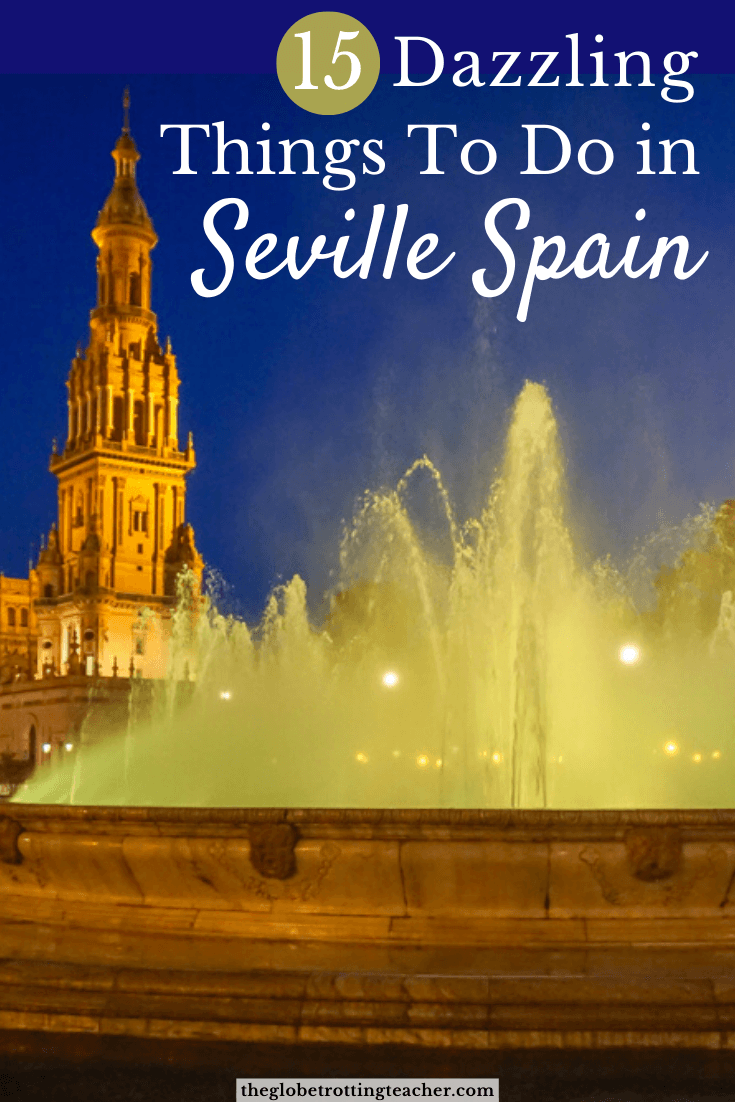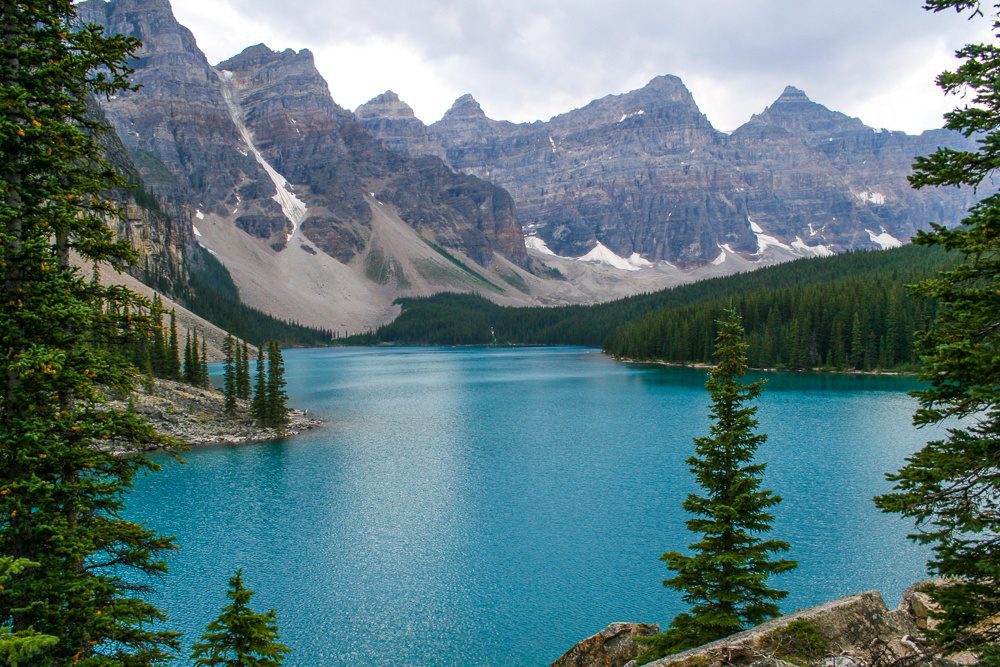Planning which things to do in Seville Spain comes with some absolute must-sees, as well as cultural experiences that’ll draw you into the city’s romantic appeal. Seville is nothing if not sensuous and full of passion that’ll spark your senses in a way like no other city in Spain can!
But with so many things to see and do in Spain, you want to plan a Seville itinerary that lets you truly experience the city while also maximizing your precious vacation days!
In this in-depth Seville guide, you’ll find:
- what to do in Seville,
- how to plan your Seville itinerary whether you plan to stay 1, 2, or 3 days,
- the best day trips from Seville, and
- important logistical information like how to get to the city and where to stay in Seville.
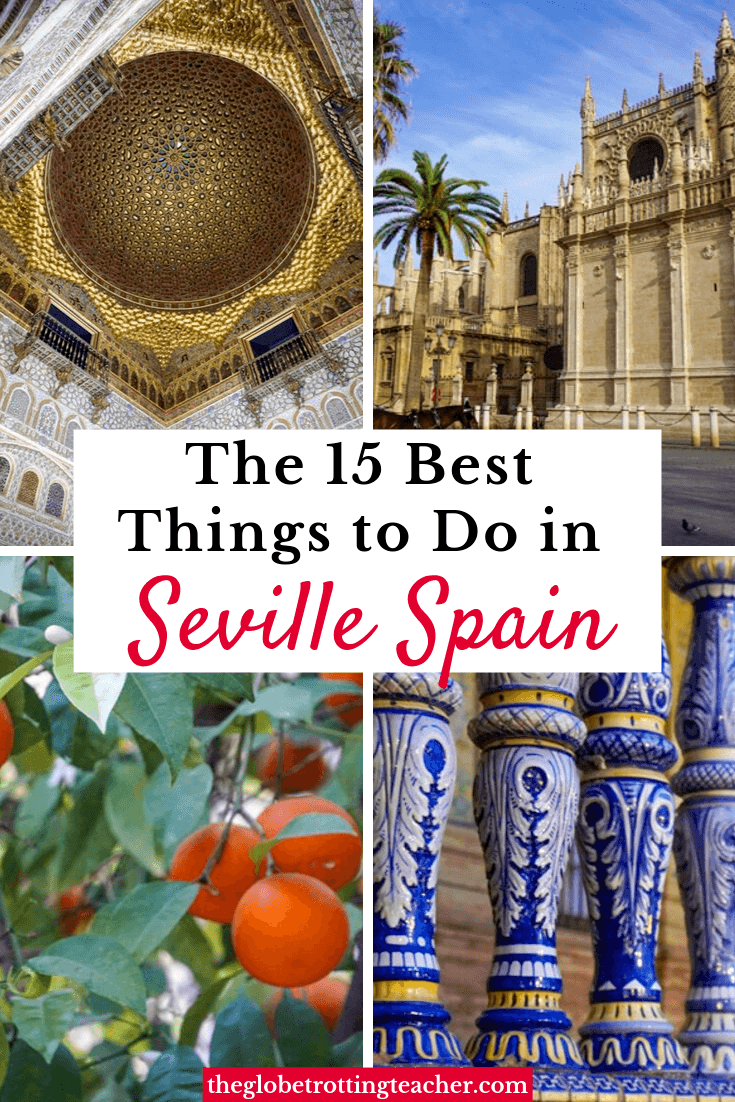
15 Dazzling Things to Do in Seville Spain
Seville will steal your heart! The winding alleyways, the scent of orange blossoms, the blend of architecture and beautiful gardens, and tapas bars as far as the eye can see. The city has all the sights of a big city like Barcelona but the charm and feel of a smaller city or town.
Seville is easily one of the most beautiful cities I’ve ever been lucky enough to visit! I’m confident you’ll also agree that Seville is SO worth visiting once you’re there.
Where is Seville?
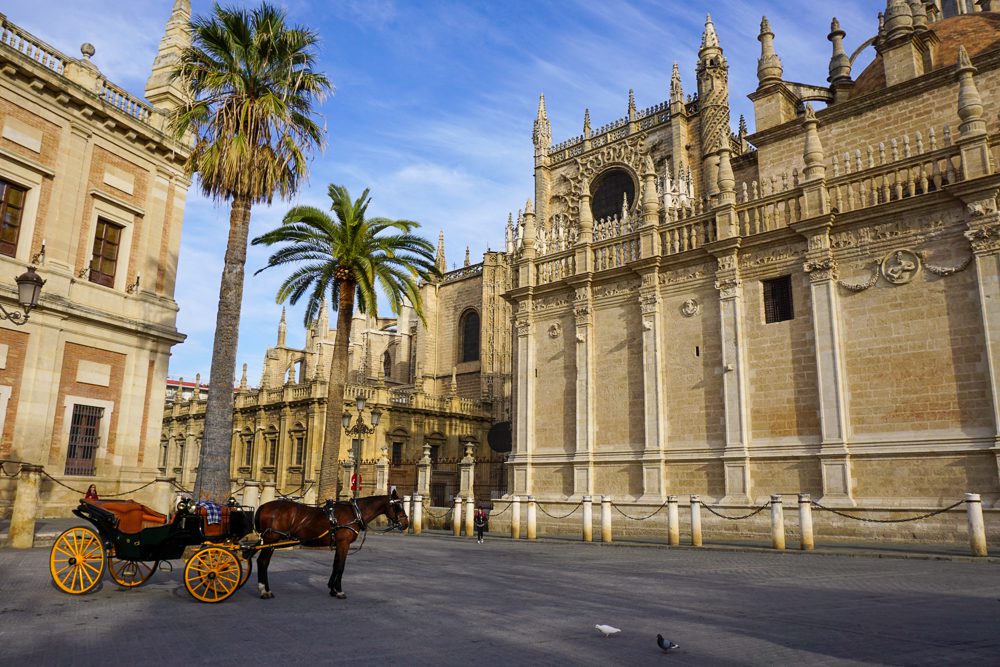
Seville is located in southern Spain’s Andalucia region along the banks of the Guadalquivir River. It’s just a couple of hours from other popular destinations like Cordoba, Malaga, Ronda, and Cadiz. There are also several popular white villages, or pueblos blancos, within easy driving distance, including Arcos de la Frontera, Sentenil, and Grazalema.
Seville is well-connected with trains, buses, an airport, and well-maintained roads. The best way to get around the Andalucia region is by car. However, you won’t need a car while in Seville, and unfortunately, parking is difficult to come by no matter in which hotel you’re staying. Most visitors pay to park in one of the city lots, which can cost 20-30 Euros per day.
One option to avoid parking fees on your Andalucia road trip would be to take the train to Seville, spend as many days enjoying the top things to do in Seville, and then rent a car to leave the city and explore the region.
Madrid to Seville Train
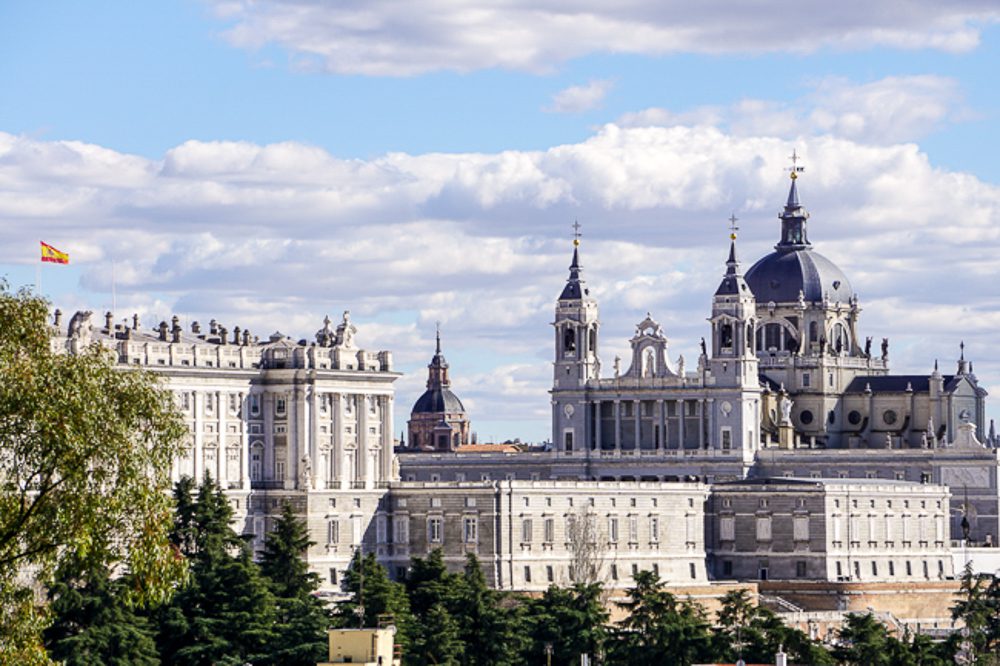
If you’re planning to see just Seville or only the major cities in Andalucia, Spain’s vast network of trains can likely connect you with where you want to go.
There are many Madrid to Seville trains every day. The train ride takes about 2 1/2 hours on Spain’s AVE high-speed train. You can also fly from Seville to Madrid, but often the ticket price is higher and you’ll spend more time when you factor in the hours at the airport before your flight.
While it’s technically possible to take day trips from Madrid to Seville (or even Malaga to Seville), you’d likely be rushing just to see all the best things to do in Seville! A better plan is to spend 2-3 days exploring the city and perhaps even taking a day trip from Seville into the Andalucian countryside.
Barcelona to Seville Train
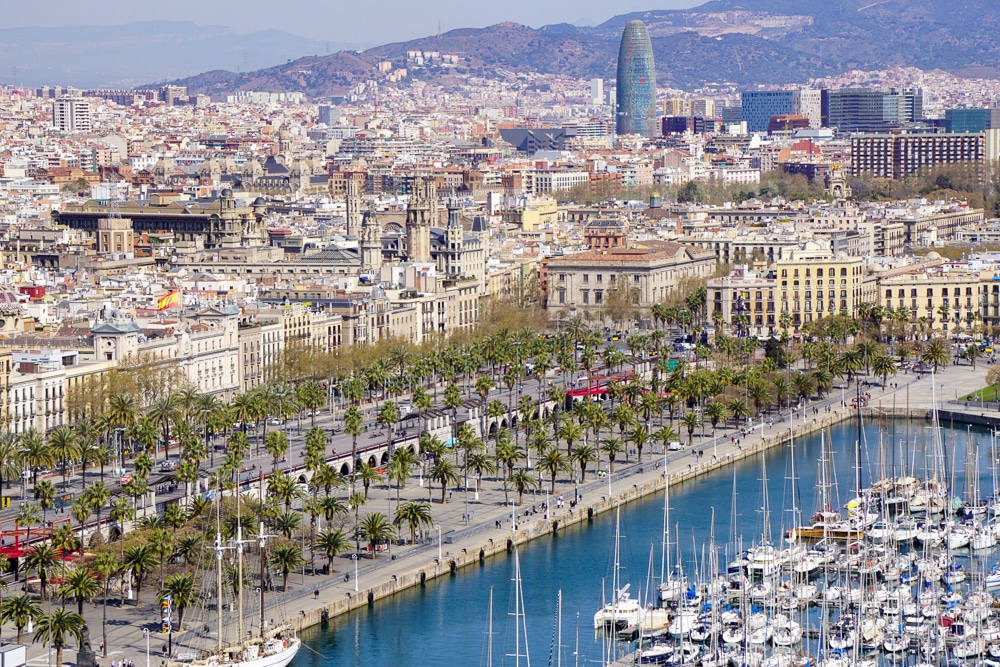
Barcelona is the top city to visit in all of Spain for international visitors, but Seville is next on the list! The tricky part when planning a Spain itinerary with both of these cities is the geography. Barcelona and Seville are on opposite sides of the country from one another.
There are 2 AVE high-speed trains each day, which go from Barcelona to Seville. The journey takes 5 1/2 hours. If you’re planning a trip to Spain and want to see both Madrid and Barcelona, as well as head south to Seville, you could start in Barcelona. Take the train to Madrid. After spending some time there, take the Madrid to Seville train to end your trip. Seville has an airport or you can return to Madrid by train to fly home.
It is also important to mention the flight option, as well. Ryanair and Vueling both offer direct flights between Barcelona and Seville taking just 90-105 minutes. The airfare might also be cheaper than the train tickets. Just be sure to consider all the costs, like airport transfers, and whether or not you’d need to check a bag on these budget carriers.
Where to Stay in Seville
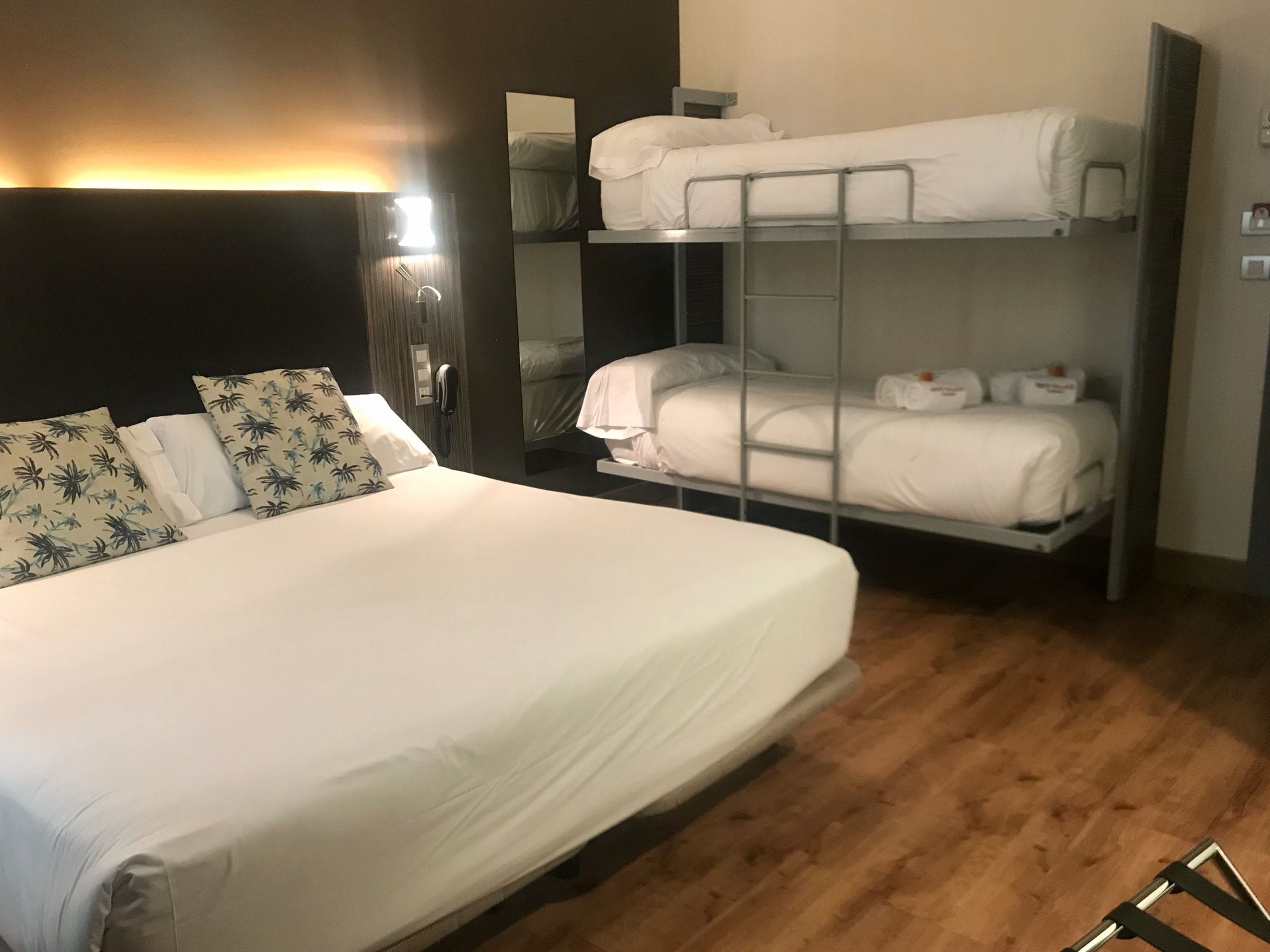
The Santa Cruz neighborhood in Seville makes for a great base to sightsee and soak up the city’s history. This medieval part of the city is the old Jewish Quarter in Seville. The area is a tangle of narrow streets now home to some of the city’s best tapas bars, shops, homes, and oldest churches.
For one of my trips to Seville, we stayed at the Petit Palace Santa Cruz, a boutique hotel that can accommodate family-sized groups. We were 4 people and the room was large enough for all of us to be comfortable.
The staff was helpful with everything we needed from parking to restaurants. The room was clean, quiet, and comfortable for 3 adults. Best of all, it’s in the heart of Santa Cruz and just 5-7 minutes walking to the Gothic Cathedral and the Real Alcazar.
Unlike the Petit Place Opera in Madrid, breakfast wasn’t included in the nightly rate and the per-person cost was too high. Instead, we walked just across the street to Bar Marmoles Cafe for fresh smoothies, croissants, coffee, eggs, and cereal for a much more reasonable price.
During another trip to Seville with my husband, we stayed at the 4-star boutique hotel, Legado Alcazar, just steps from the Royal Alcazar, the Cathedral of Seville, and numerous cafes and restaurants.
We loved the updated and contemporary rooms with preserved architectural details from the Moorish and Medieval ruins that were once here. The breakfast was great and the staff helpful with all of our needs.
When is the Best Time to Visit Seville?
Seville and all of southern Spain heat up in the summer! Still, it’s an incredibly popular time to visit. If you’re flexible with your travel, go instead in spring or fall. I’ve visited the city during both of these travel shoulder seasons and found fewer people, shorter lines, and pleasant temperatures for walking and sightseeing.
I’d much rather visit Seville in November or March than in July or August.
What to Do in Seville

1. Marvel at the Real Alcázar.
The Real Alcazar is a UNESCO World Heritage Site and, like the Alhambra, one of the most spectacular sights in all of Spain. It’s also the oldest royal palace in Europe still being used! Of all the Seville things to do on this list, the Alcazar was my favorite!
The palace’s intricate tile work, architecture, and gardens combine for a breathtaking experience. Game of Thrones fans may even recognize the Royal Alcázar of Seville as a filming location from Season 5.
Although the castle was built for the Christian King, Peter of Castile, it was built on the site of a former Muslim fortress. The lower-level arches and design show the palace’s Muslim past but the upper-level arches and design are clearly more European and reminiscent of the Renaissance. Altogether, the combination is stunning!

The Alcazar Gardens are also not to be missed. You’ll fall in love with the orange groves and the trellis of purple wisteria. Stroll the walkways, stopping at the intricately tiled benches to sit and enjoy the fragrance of the flowers radiating from every direction. Truly, the Alcazar gardens would be a site all unto themselves if it weren’t for the gorgeous palace to upstage them!
Plan to spend at least a couple of hours at the Real Alcazar. After getting in when the doors opened, I spent just about 3 hours exploring the palace and the gardens. It’s absolutely the top thing to do in Seville!
How to Avoid Waiting in Line at the Real Alcázar
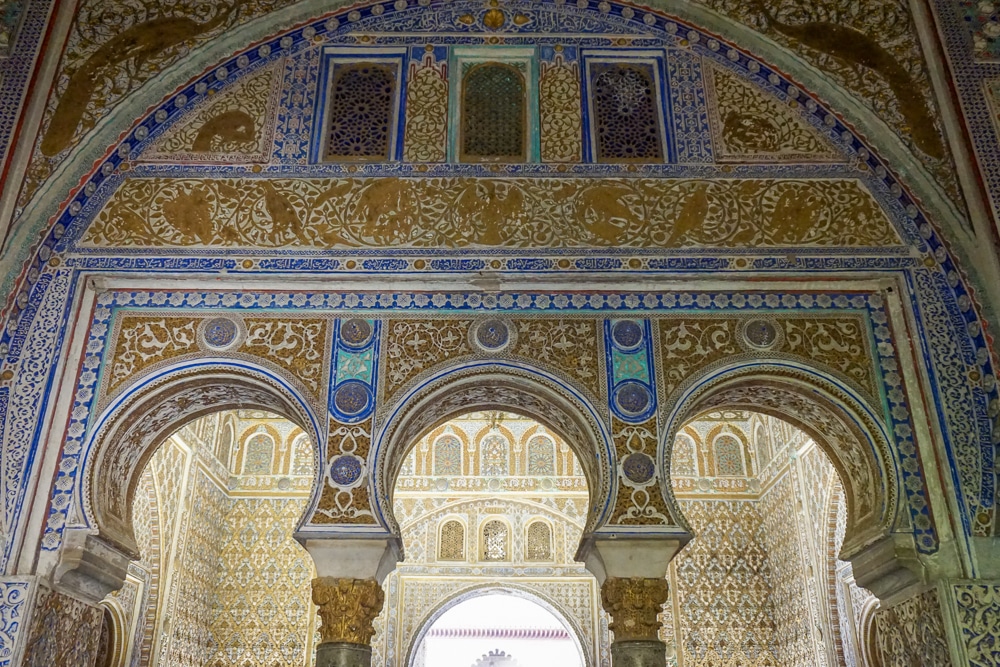
The best way to avoid a potentially lengthy line is to book your tickets in advance.
I realize this might be something you read all the time about many top sights. However, it’s not to be taken lightly with the Real Alcazar. Of all the things to do in Seville, this is the one that every visitor to the city wants to do.
The lines are long and only a certain number of people are admitted each day. If you’re spending just a few days in Seville, you run the risk of missing out altogether on this spectacular place if you delay booking your tickets, especially during peak times like vacation weeks and summer.
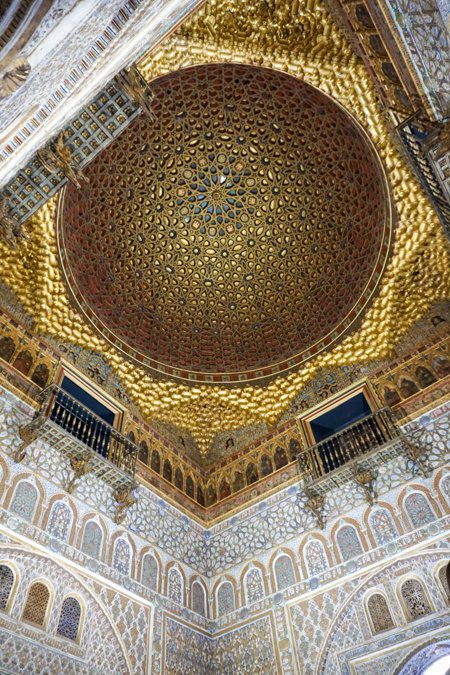
But even if you’re visiting Seville in the off-season, expect a line to form starting from early in the morning. For the Real Alcazar, it’s a must to book your tickets in advance to save time and ensure you will be able to visit inside.
If you’re visiting during the peak summer season and advance tickets for your dates are sold out, consider booking a Real Alcazar guided tour.
Not only will it be a bonus to better understand the history of this incredible site, but you also don’t want to risk waiting in line for hours and wasting a chunk of the day in Seville.
2. Visit the Cathedral of Seville.
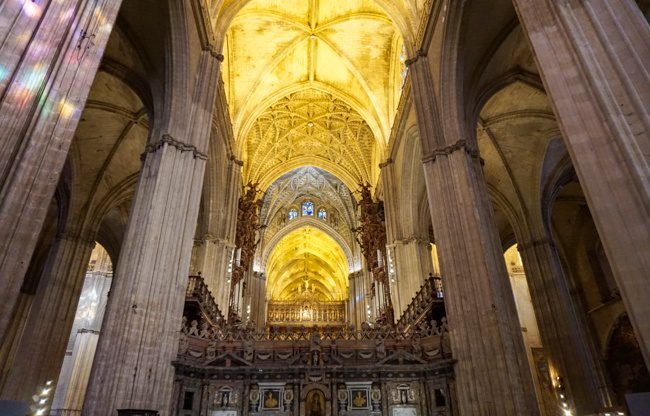
The massive Cathedral of Seville is the largest Gothic Cathedral in the world and a UNESCO World Heritage Site. It rightfully tops most lists of what to see in Seville. Today, it functions as a Catholic Cathedral. However, its mixed history can be seen in its architecture.
In the 11th and 12th centuries, the structure was a grand Mosque, whose outer walls and tall tower are still standing today. Once Seville was reconquered in the mid-1200s by the Christians, it was turned into a Christian place of worship with Mosque-like features, before eventually becoming a Gothic Cathedral in the mid-1400s.
To say the Cathedral is impressive or spectacular doesn’t do it justice. No matter how many European cathedrals you’ve visited, the sheer size and the scope of history are jaw-dropping in the same way Montserrat’s location is! Inside is divided into altars and mini-chapels to explore and rooms where historic relics are on display.
As your eyes follow the enormous marble columns up 10 stories tall, you’ll land on the Gothic arches that serve as the backbone of the Cathedral and were an engineering feat when they were first used in the Middle Ages.
The tomb of Christopher Columbus and his son are said to be here, as well (despite the controversy over whether his remains may actually be resting in the Dominican Republic).
An audio guide and map or a guided Cathedral tour will help orient you inside and increase your appreciation of the Cathedral’s history and architecture.
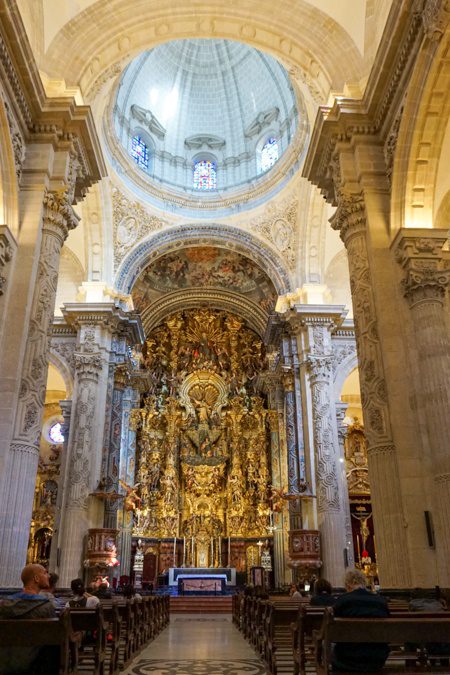
Don’t waste time standing in the long lines to get inside! Get your skip-the-line Cathedral tickets in advance. After the Alcazar, the Cathedral is also one of the top things to do in Seville.
Or go to the Iglesia Colegial del Salvador first, which usually has much smaller crowds, and purchase a combined ticket with the Cathedral. After seeing the baroque Church that was once a Mosque, visit the Cathedral with the same ticket and avoid the line.
Be sure to follow the signs for the correct entrance depending on your ticket type because the Cathedral of Seville has several different lines for people with tickets and those still needing to buy them.
The Seville Cathedral hours are mainly 10:45 am – 5 pm Monday-Saturday. These hours are extended slightly in the summer months and limited to the afternoon hours on Sundays because of morning Mass times.
3. Climb to the Top of Torre Giralda.

La Giralda tower is now part of the Cathedral of Seville but stands as a piece of the past from the Mosque that was originally on this site. The 360° views from the top of the bell tower give a fantastic birds-eye view of the city and the Patio de los Naranjos (orange tree courtyard) below. It’s worth the climb!
Don’t worry if you’re not a fan of stairs! The tower is a series of ramps up to the top. Along the way, tiny windows give a sneak peek of the city views to keep you motivated on your climb. Begin your way up the tower from inside the Cathedral. Tower access is included with your Cathedral entry ticket.
ProTip: Combine the Alcazar, the Cathedral, and Torre Giralda into a single ticket and go with a local guide to avoid lines and learn about Seville’s incredible history.
4. Gush Over the Gorgeous Plaza de España.
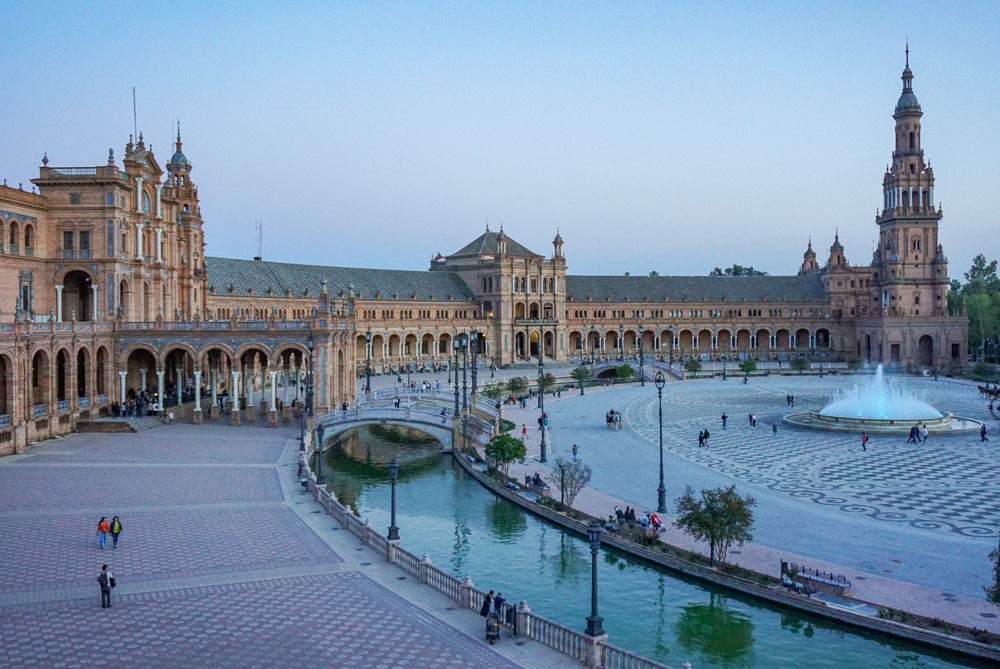
This wide-open plaza is not only the most spectacular plaza in Seville but also one of the most picture-perfect throughout all of Europe.
Plaza de Espana sits along the edge of Maria Luisa Park (Parque de María Luisa). It has a semi-circle of buildings flanking the perimeter on one side and a moat with arched bridges running parallel alongside them. At the center, a grand fountain completes the striking plaza view.
Plaza de Espana was built in 1928 with a blend of Renaissance and Moorish revival styles. The walls of the plaza are covered with beautiful ceramic tiles representing the different regions of Spain. Even the banisters of the bridges crossing over the moat are decorated with blue, white, and yellow tiles cut to precision for every curve and spiral.
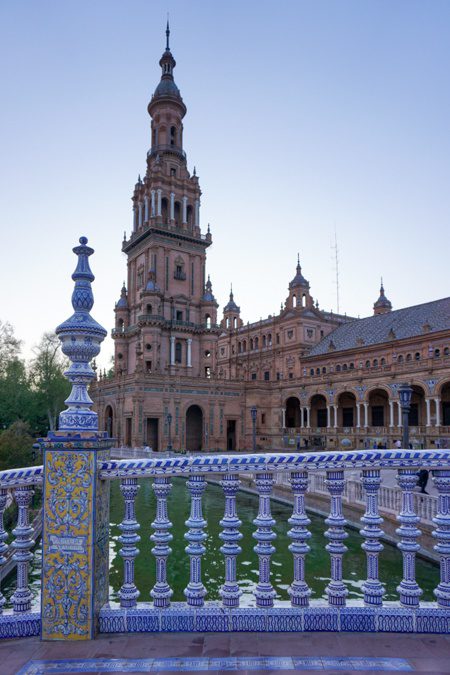
Go later in the day and time your visit to see the plaza both in the daylight and as night falls when the plaza lights up. If you’re lucky, you might even come upon a flamenco performance in one of the building alcoves.
Even if you’re trying to see Seville in a day, Plaza de Espana is a must-see!
5. Stroll through Parque de Maria Luisa.

Need a break from Seville sightseeing?
Parque de Maria Luisa is just alongside Plaza de Espana and has meandering paths for a stroll and shady nooks perfect to escape the city hustle for a rest.
The grounds are actually the former gardens of a palace and come complete with fountains and monuments. Yet, despite being Seville’s most central urban green space, the park is surprisingly uncrowded and peaceful. It’s one of those things to do in Seville that makes you feel as if you’ve had a more local experience.
You can also explore this park and several other must-see spots around the city as part of a Seville bike tour.
6. Explore Barrio Santa Cruz.
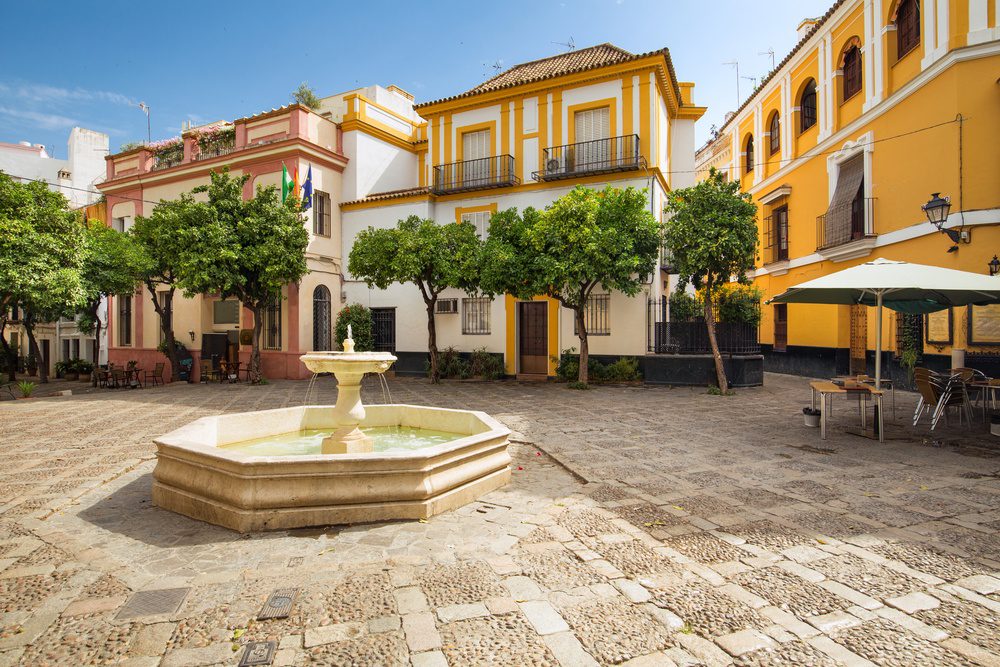
Situated in and around the Cathedral and Real Alcazar, the Barrio Santa Cruz is a maze of narrow, medieval streets and alleyways. This neighborhood is Seville’s historic Jewish Quarter lined with shops selling everything from clothing to art and Tapas bars serving food and drink throughout the day.
As you wander, you’ll inevitably discover some of the city’s oldest churches, former palaces, and flowers blooming on patios lined with orange trees. In this neighborhood, Seville’s rich history is on full display!
If you’d like to uncover more of this neighborhood’s long past, opt for a guided Santa Cruz walking tour to learn more about what this Seville neighborhood was like before the 1490s.
7. Learn about Maritime History at Torre del Oro.
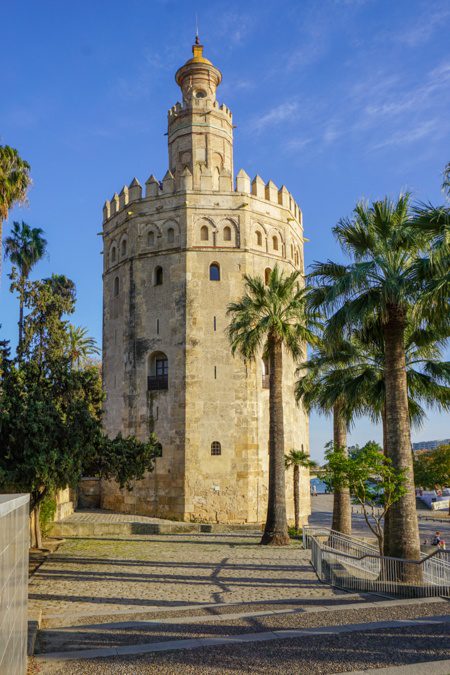
Once a military watchtower converted into a prison and now a Maritime Naval Museum, the Gold Tower sits directly along Seville’s Guadalquivir River flanked by palm trees. Visitors can climb to the top for scenic views over the river and city.
The Torre del Oro also serves as a helpful marker along the river as you orient yourself while walking between Seville’s historic center, the waterfront, and the Triana neighborhood.
ProTip: Mercado Lonja del Barranco is a modern market along the riverfront where you can grab a bite or sit outside with a drink. There are certainly more authentic places to eat just over the bridge in Triana or back in Barrio Santa Cruz. But, its location makes it an ideal spot to sit and recharge your batteries.
8. Get Local in Triana.
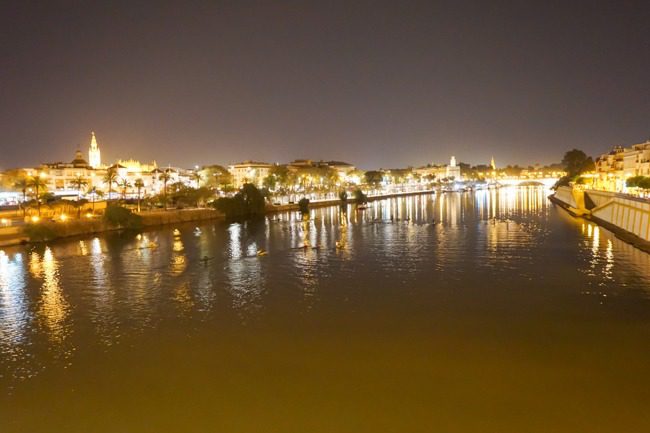
The Triana neighborhood is just over the Guadalquivir River via the Puente de Isabel II, otherwise known as the bridge into Triana. Be sure to stop and take some photos overlooking the river as you cross! 😉
Triana is known for its authentic Mercado de Triana, a local vibe, as well as its famous ceramic tile shops, tapas, and nightlife. You’ll come upon the Mercado first. It’s just on the other side of the bridge after passing a small chapel. The Mercado is open from 9 am – 3 pm and sells fresh produce, meats, and fish. You’ll also find a few spots inside the market to sit for a small bite.
Triana is the heart of azulejo or glazed tile making. Southern Spain is known for its vibrant tiles and mosaics seen throughout the region on everything from architecture to dinner plates.
Browse the shops in the neighborhood, and along the way come across a historic church, the Iglesia de Santa Ana which dates back to the 13th century. Shopping for ceramic tiles is one of the most popular things to do in Seville. If you were planning to take some home as a souvenir, here’s the place to buy.
Don’t leave until you’ve enjoyed one (or some) of the many Tapas restaurants in Triana. Better yet, plan an evening out with a Flamenco show first and then join the locals for a traditional late dinner.
9. Go to a Flamenco Show.
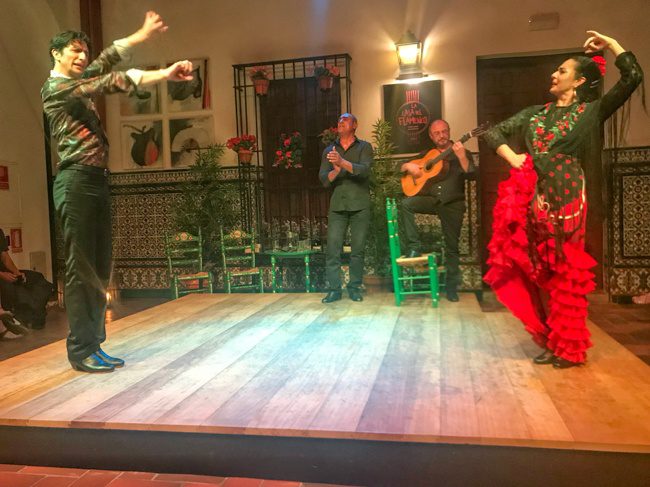
Whether you see a Flamenco show in Triana or elsewhere, it’s a must-do in Seville.
Flamenco has a strong connection to the city. It’s not certain if it originated in Seville exactly. But, its roots are firmly established in the Andalucia region stemming from when the area was ruled by the Moors between the 8th and 15th centuries.
The storytelling-dance art form has morphed throughout history and has been adapted by different cultures around the world. But a traditional Flamenco show includes dancing, singing, and guitar playing. The performers usually express some kind of sadness or other passionate emotion.
Throughout your time in Seville, you might see pop-up Flamenco performances perhaps as you stroll through places like Plaza de Espana. But be sure to get your Flamenco tickets to feel the passion of this art form in a dedicated performance from start to finish. Without a doubt, it’s one of the best things to see in Seville.
ProTip: Skip dinner at Flamenco shows. Often the food caters directly to tourists. Better to watch the show and head out for Tapas afterward.
10. Photograph Sweeping City Views at Las Setas.
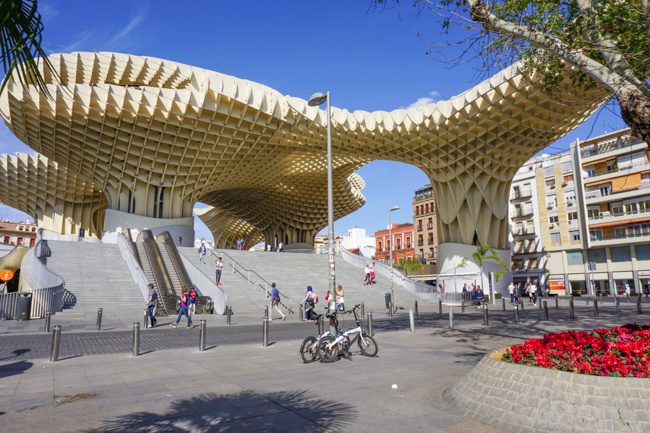
Nicknamed the mushrooms because of their appearance, Las Setas (formerly known as Metropol Parasol) is a wooden piece of modern art meant to look like it’s offering shade to everyone who passes by. Admittedly, this modern installation is one of the more unusual things to do in Seville and even quite unexpected after spending time immersed in Seville’s history.
There’s an elevator from the lower level that brings you to the top for sweeping views over the city. You’ll also have the chance to walk through a small museum where you can see some historic ruins. The lines to the top are longest at sunset and in the evening because of the stellar views.
To go deeper and see how these views and the city of Seville have changed over time, consider going with a guide and using virtual reality to enhance your visit.
11. Discover a Hidden Gem at Casa de Pilatos.
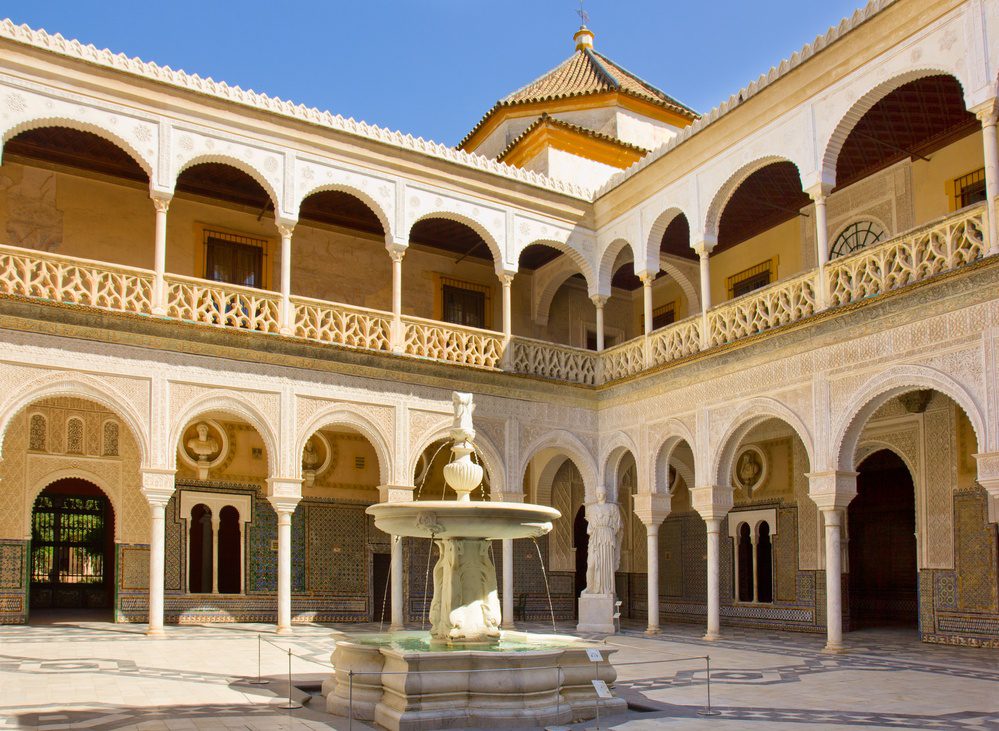
This private palace has been (partially) opened to the public, yet remains somewhat of a hidden gem in Seville. It’s about a 10-minute walk from the Gothic Cathedral and well worth a visit.
The architectural style blends both Renaissance and Moorish styles with features like Roman mosaics and sculptures mixed with glazed Spanish tiles and an inner courtyard and fountain typical in Andalucia homes.
The ground floor is open for visitors to explore independently. This also includes a patio, water fountains, and one of the gardens. You’ll need an upgraded ticket to tour the upstairs with a guide, which is really worth it if you have the additional time to spare.
12. Eat Plenty of Tapas.
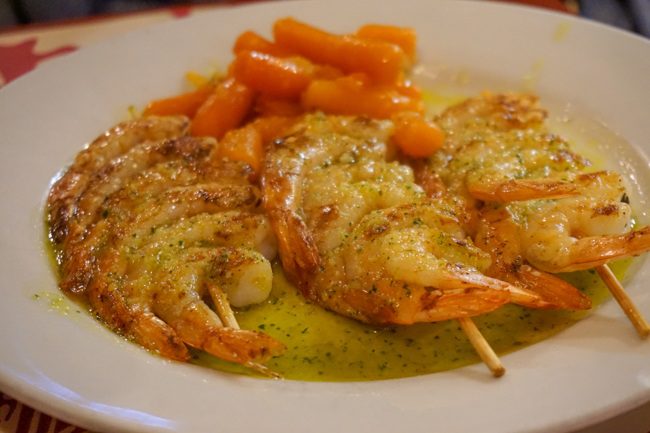
Spain is all about food and Seville embodies this as well, if not better, than any other city in Spain. But with more than 4k places to have tapas, deciding what to do in Seville Spain is a lot easier than deciding where to eat!
No matter how many days in Seville you have, there just won’t be enough time or stomach space for all the delicious eats in Seville.
Seville is the heart of Tapas culture with thousands of restaurants in the city serving croquettes, fresh meats, fish, spinach with garbanzo beans, eggplant with honey, and salmorejo, to name a mouth-watering few.
For Seville visitors, Santa Cruz and Triana will be the best neighborhoods to eat Tapas. You can even do as the locals do and go from one restaurant to the next to sample the best bites in each. It’s fun (and worth it!) to do a Tapas Crawl with a local who can steer you directly towards the best bites!
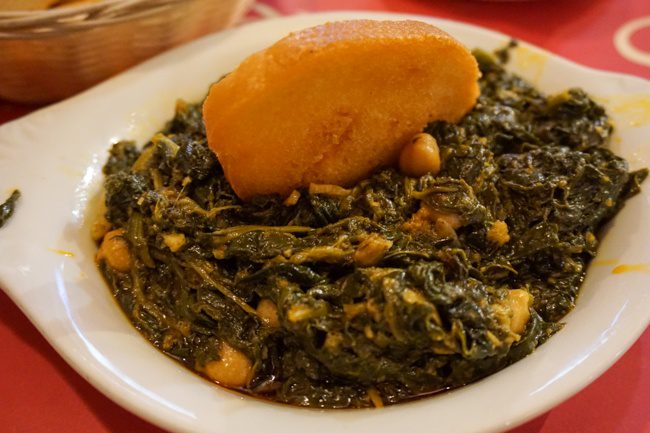
If you’re in the Santa Cruz neighborhood, stop at Las Teresas. There are just a few tables inside and out but my favorite dish of spinach and garbanzo beans was the best I had.
13. Enjoy a glass of Sangria at Hotel Alfonso XIII.
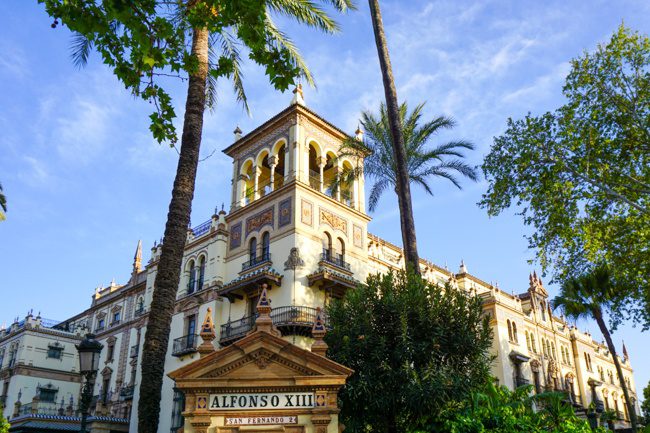
Named after the King who commissioned the building, Hotel Alfonso XIII is the utmost when it comes to luxury hotels. The architecture captures the essence of Seville with its blended Mudejar style and lavish elegance. (Those of you with Marriott points can book award nights at this Luxury Collection Hotel.
The great news is everyone can enjoy this noble lifestyle, at least for a short while. The hotel boasts an outdoor patio overlooking the main road where you’ll also find the Cathedral of Seville. Order a glass of sangria and let your surroundings take you back to the opulence of a time gone by.
ProTip: Hotel Alfonso XIII is along the way to Plaza de Espana. It could be a great place to stop for a drink before heading to the plaza to catch the end-of-day light and the night lights turn on in the square.
14. Immerse Yourself in a Seville Experience.
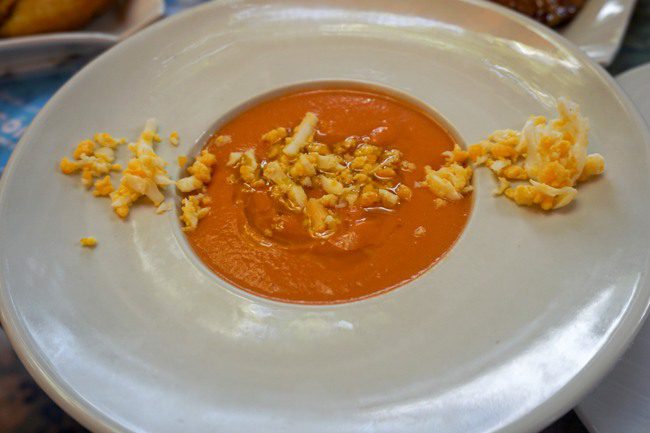
It goes without saying Seville’s top sights are a must-see. But, why not go further and enhance your Seville visit with a first-hand cultural experience?
Learn how to prepare your favorite Tapas and Andalucian dishes during a Spanish cooking class led by a trained chef. You’ll shop at Mercado de Triana and then in a hands-on class, cook and eat a full menu of dishes. I’ve taken cooking classes in several countries and always love trying out my new skills back at home.
Inspired by the Flamenco dancers you’ve seen in Seville? Give a Flamenco dance lesson a try! You don’t need any prior dance experience. The dance instructor will teach you the basic foot movements and arm positions and help you better understand the art of Flamenco by getting up and doing instead of watching.
15. Visit Seville’s Plaza de Toros.
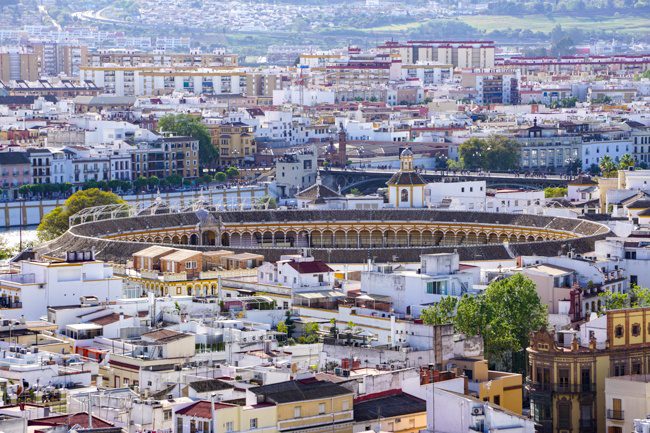
Bullfighting is a part of Andalucian and Spanish culture whether you agree with it or not. While I may be in the not category, visitors are interested in the arena and museum as a place to learn about the history and cultural significance of bullfighting. Still, it’s one of the most controversial places to visit in Seville.
I did visit the bull ring in Ronda and did not feel the need to visit again in Seville. I was, however, surprised at the size of the arena. It’s much bigger than imagined.
1 Day in Seville Itinerary
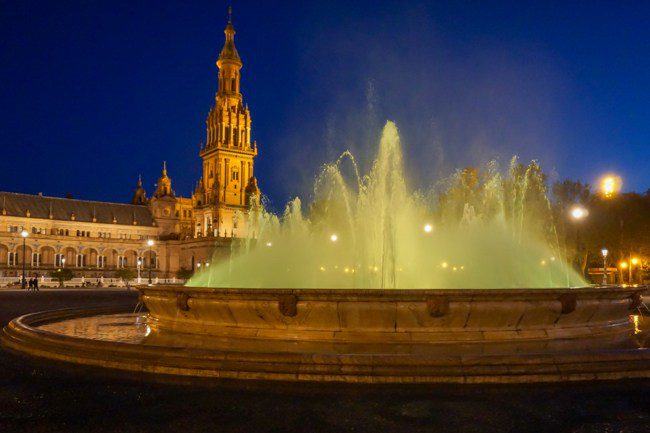
With just one day in Seville, you’ll want to focus on the top Seville attractions and experiences.
Start your day at the Real Alcazar. Be sure to get tickets or arrange a tour, so you aren’t wasting the day in line. Of all the Seville sights, the Alcazar is the one to prioritize.
After this, go to the Cathedral of Seville. Again, avoid the lines by getting your skip-the-line ticket in advance, booking a tour, or using the combined ticket trick described above. Don’t miss the opportunity to climb the Torre Giralda to see views overlooking the city.
Next, wander into the Barrio Santa Cruz to explore this historic neighborhood. Along the way, stop for tapas. Seville is a foodie’s dream come true!
Afterward, stroll towards the Plaza de Espana, admiring Seville’s architecture and ambiance as you go. Spend time taking in the beauty of Seville’s most beautiful plaza. The tilework is meticulously done and the whole scene captures the best of Seville.
If time allows, walk into Parque de Maria Luisa just next to Plaza de Espana or have a glass of sangria on the outside patio at the opulent Hotel Alfonso XIII before making your way back to the Seville train station.
2 Days in Seville
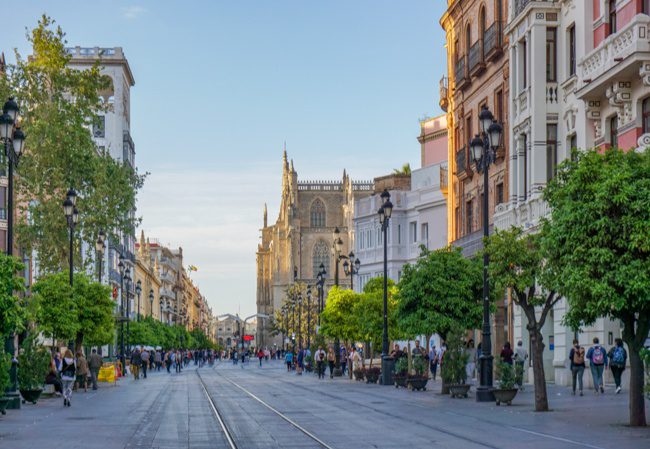
A Seville 2-day itinerary should begin by following the itinerary above for your first day. If you’d like to split up the Alcazar and the Cathedral into different days, blend the sights and activities for both days to fit your needs. I recommend, though, still seeing the Alcazar first thing in the morning.
Start your day at Casa de Pilatos. If you’re staying in the Santa Cruz neighborhood, it’s likely just a short walk from your hotel. Spend about 60-90 minutes exploring the noble palace.
Afterward, make your way back toward the riverfront admiring Seville’s architecture along the way. Stop at Torre del Oro to take photos. Climb to the top if you’d like to like to see the city views.
Continue along the river. If you’d like to see the Plaza de Toros, it’s just a few minutes from Torre del Oro on the opposite side of the street.
Walk the riverfront promenade until reaching Puente de Isabel II or the bridge into the Triana neighborhood. The Mercado de Triana is just across the bridge and most active in the first part of the day. You might even plan to take a Spanish cooking class right in the Mercado!

Take some time to walk through the Triana neighborhood. Do some ceramic tile shopping and discover the churches here like Iglesia de Santa Ana. Triana has plenty of authentic Tapas restaurants to choose from if you’d like some lunch.
Later in the afternoon when some shops and restaurants close for a few hours, walk back over the bridge and toward Metropol Parasol. The late afternoon and evening are the best times to capture the city views from the top.
Finish your two days in Seville with a Flamenco show and, of course, more Tapas back in Santa Cruz…two of the best things to do in Seville at night!
3 Days in Seville

With three days in Seville, you have options. You could expand upon this list and visit the Museum of Fine Arts of Seville, see more of the city’s churches, or even push the whole 3-day itinerary back and start your time with a Seville walking tour or with an introductory bike tour.
If your trip to Seville isn’t part of a larger Andalucia itinerary, I recommend using this 3rd day to take a Seville day trip.
Andalucia has so many incredible places to visit, not to mention nearby Tarifa is the gateway to Morocco! My pick would be Cordoba, which is accessible by car and by train. The city dates back to Roman times and has several must-see sights in Andalucia including the incredible Mezquita (Mosque-Cathedral).
Seville Day Trips
Seville is positioned well in Andalucia making it a convenient base to explore southern Spain.
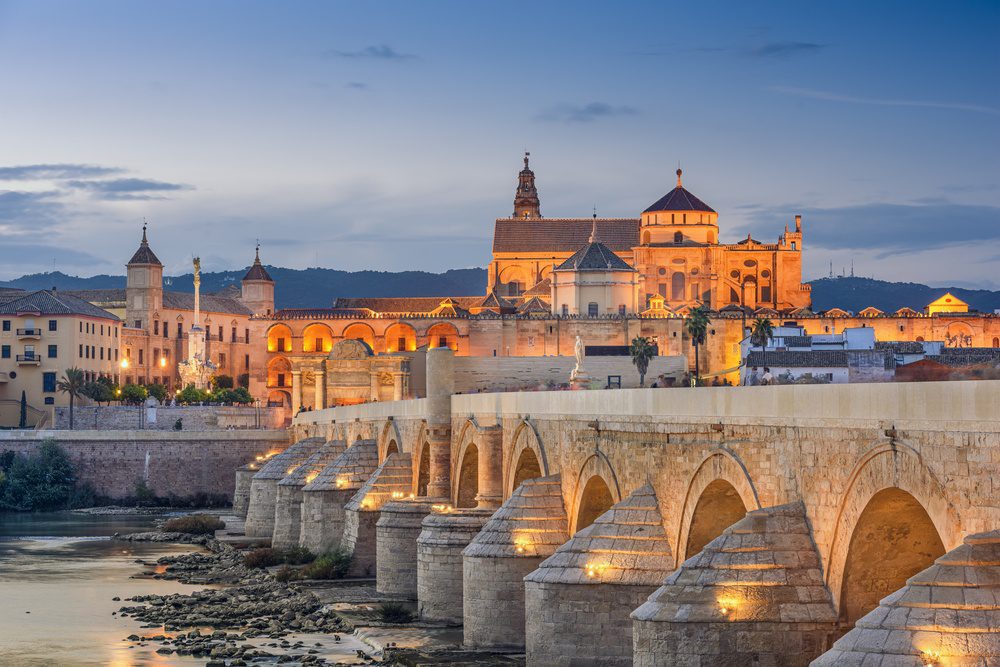
The ancient city of Cordoba is just an hour and a half by car and 45 minutes by train. The city boasts 4 UNESCO World Heritage Sites including the spectacular Mosque-Cathedral and history dating back to the Roman Empire. Cordoba is one of the best day trips from Seville and an absolute must for any southern Spain itinerary!
If you’d rather go with a guide, as well as make a stop in Carmona, book a full-day Cordoba tour.
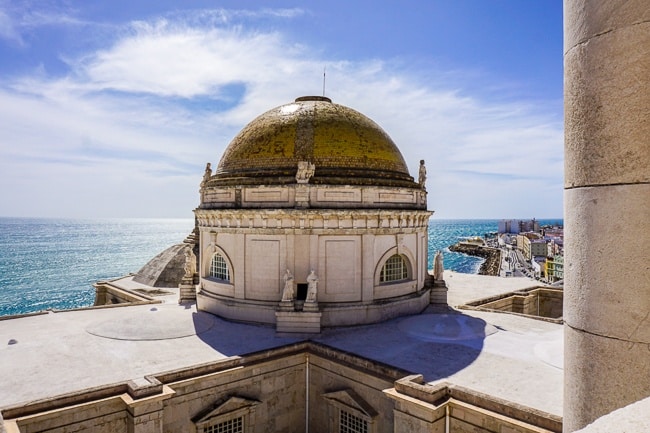
Cadiz sits along Spain’s southern coast complete with turquoise water, white sand beaches, and historic architecture including a baroque-style Cathedral offering sweeping views of the sea.
Cadiz is also an hour and a half by car from Seville and just under 2 hours by train. The tourism office has done a great job creating designated color-coded walking routes throughout Cadiz’s center so you can easily explore the city’s top sights and neighborhoods for the day.
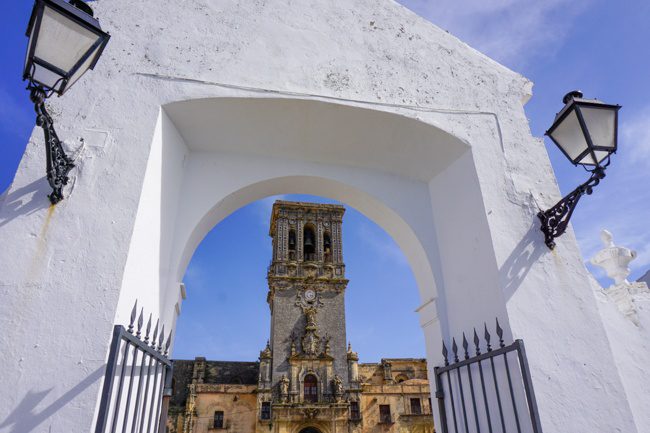
Andalucia is known for its Pueblos Blancos or white villages positioned along the region’s peaks and valleys. Arcos de la Frontera, just an hour or so by car from Seville, is one of the prettiest of them all!
Its elevated position on a rocky summit made the area a strategic outpost for defense. Historic evidence reveals the Roman, Moorish, and Christian influences on architecture and food.
The Iglesia de San Pedro dates back to the 15th century and sits atop the remnants of a former Moorish fortress. A medieval castle and its towers are still intact and can be viewed from the outside.
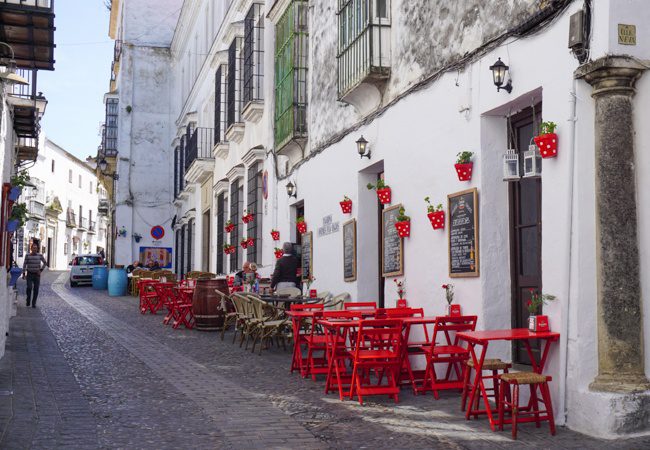
Mostly though, just wander among the white-washed buildings huddled together adorned with hanging flower pots. Then, take a small break to taste Grandma Maria’s soup of the day and watch the goings-on of village life.
If you haven’t rented a car for your trip to southern Spain, you might be interested in a white villages guided tour. However, if you have the time, opt for your own rental car and spend at least a day in Ronda!
Things to Do in Seville Bottom Line
Seville will entice you with its historic landmarks, delicious food, and captivating vibe! It rightfully deserves a spot on any Spain travel itinerary. It’s the perfect place to start a trip through southern Spain or as part of a trip to see the top cities in Spain like Madrid and Barcelona.
Either way, you’re sure to fall for spectacular Seville!
Which things to do in Seville are on your list?
Like this post? Please share it on social media using the share buttons below.
